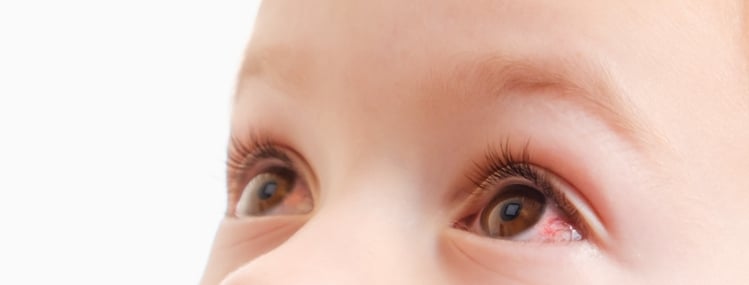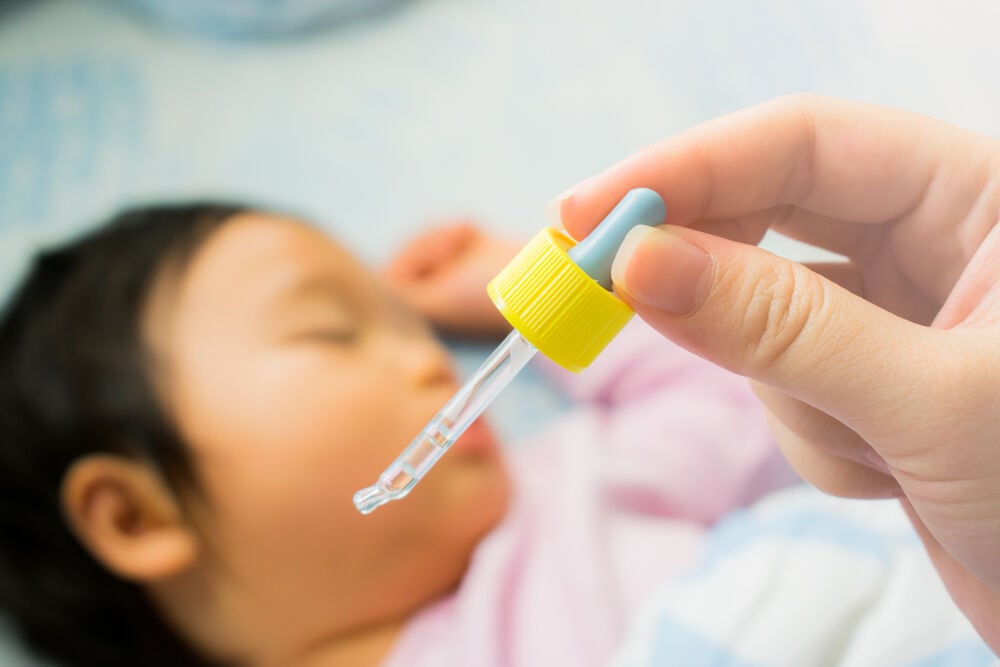Your baby could develop red eyes for a variety of reasons, from a mild case of conjunctivitis to the more serious uveitis. We can help you learn to identify the symptoms of severe conditions so you'll know when to call the doctor. Learn more about what causes bloodshot eyes in your baby and when to call the doctor in this article.
-
Tracking cycle
-
Getting pregnant
-
Pregnancy
-
Help Center
-
Flo for Partners
-
Anonymous Mode
-
Flo app reviews
-
Flo Premium New
-
Secret Chats New
-
Symptom Checker New
-
Your cycle
-
Health 360°
-
Getting pregnant
-
Pregnancy
-
Being a mom
-
LGBTQ+
-
Quizzes
-
Ovulation calculator
-
hCG calculator
-
Pregnancy test calculator
-
Menstrual cycle calculator
-
Period calculator
-
Implantation calculator
-
Pregnancy weeks to months calculator
-
Pregnancy due date calculator
-
IVF and FET due date calculator
-
Due date calculator by ultrasound
-
Medical Affairs
-
Science & Research
-
Pass It On Project New
-
Privacy Portal
-
Press Center
-
Flo Accuracy
-
Careers
-
Contact Us
Why Does Your Baby Have Red Eyes? A Parents' Guide

Every piece of content at Flo Health adheres to the highest editorial standards for language, style, and medical accuracy. To learn what we do to deliver the best health and lifestyle insights to you, check out our content review principles.
What causes red eyes in babies?
The following are common causes of eye redness in babies:
1. Viral conjunctivitis
Also known as pink eye, viral conjunctivitis is caused by a virus. It often occurs along with a cold or sore throat. The symptoms of viral conjunctivitis are eye redness in one or both eyes, tearing, and itchiness.
2. Bacterial conjunctivitis
Bacterial conjunctivitis is caused by bacteria such as streptococcus, Hemophilus, or staphylococcus. In addition to red eyes, itchiness, and tearing, bacterial conjunctivitis also causes a thick yellow discharge that can become crusty.
Take a quiz
Find out what you can do with our Health Assistant
3. Allergic conjunctivitis
Allergic conjunctivitis rarely causes red eyes in babies, but your child may have an allergy to dust, smoke, or another allergen. The symptoms of allergic conjunctivitis are eye redness, watering, and swelling.
4. Corneal trauma/abrasion
Corneal abrasion or trauma happens when there's a superficial injury or scratch on the cornea. The cornea is a protective, clear window at the front of the eye. Your baby's cornea could be scratched by dirt, sand, dust, metal particles, wood shavings, or the edge of a piece of paper. The symptoms and signs of corneal trauma are pain, tearing, redness, and sensitivity to light.
5. Subconjunctival hemorrhage
A subconjunctival hemorrhage happens when a small blood vessel (capillary) breaks underneath the conjunctiva of your baby, causing a bloodshot eye. The conjunctiva can't absorb the blood quickly, so the blood is trapped there, causing red eyes. A subconjunctival hemorrhage is generally harmless and disappears on its own in a couple weeks. A subconjunctival hemorrhage usually results in a red patch on the sclera (white) of the eye.
6. Blepharitis
Blepharitis is inflammation of the eyelids. It generally affects both eyelids and can be caused by bacteria or malfunctioning/clogged oil glands in the eyelids. If your baby has blepharitis, they may have watery and red eyes, itchy and swollen eyelids, sticky eyelids, flaky skin around the eyes, crusty eyelashes in the morning, and eyelashes falling out.
7. Periorbital cellulitis
Periorbital cellulitis is a bacterial infection of the eyelids or the skin surrounding the eyes. It can affect one or both eyes. The symptoms of periorbital cellulitis are swelling and redness around the eyes (the eyes may swell closed); a scratch, insect bite, or cut near the eye; and tenderness of the affected area. If your baby has these symptoms, you should consult a doctor immediately.
8. Corneal ulcer
An open sore on the cornea is known as a corneal ulcer. Most corneal ulcers are caused by bacterial or viral infections. They can also be caused by small tears from scratches or as a result of dry-eye disorders. The signs and symptoms of a corneal ulcer are eye redness, severe pain, tearing of eyes, swollen eyelids, pussy discharge, and a round white spot on the cornea.
9. Uveitis
Uveitis is a type of inflammation of the eyes affecting the uvea (the middle tissue layer in the eyewall). The signs of uveitis often appear suddenly and quickly get worse. They include blurred vision, pain in the eyes, and eye redness. The condition can affect one or both eyes.
The condition can be caused by an infection, injury, or an inflammatory/autoimmune disease. It is a serious disease that can result in permanent vision loss. It's important to diagnose and treat it early, so call the doctor if you suspect your baby has this condition.
10. Episcleritis
An inflammation of the episclera (a thin layer of tissue on top of the white of the eye) is known as episcleritis. It can affect one or both eyes. In most cases, no specific cause can be found. The signs and symptoms are typically bloodshot eyes. Some babies may also have burning or irritation and sensitivity to light. This condition usually doesn't cause pain, so if your baby's eyes seem painful or sore, something else might be wrong.
Red veins in babies' eyes: what causes it?
Your newborn baby might have red veins in their eyes from a subconjunctival hemorrhage (see above). These blood vessels can break due to changes in pressure during delivery.
How to treat eye redness in babies

The treatment for red eyes in babies depends on the cause.
To treat allergic conjunctivitis, your baby's doctor may prescribe eye drops to relieve the symptoms. For uveitis, the goal is to treat the specific condition causing it and decrease the inflammation. The doctor may prescribe eye drops to reduce inflammation or antivirals/antibiotics to treat an infection.
For blepharitis, the doctor may suggest using warm compresses and gently cleaning your baby's eyes. Eye redness due to subconjunctival hemorrhage resolves on its own within a couple weeks.
If your baby's red eyes are caused by a corneal abrasion, call the doctor as soon as possible. Otherwise, an infection can occur and lead to a corneal ulcer. You can rinse your baby's eyes with a saline solution or clean water to wash out the foreign object. Don't rub their eyes after an injury.
Eye redness from episcleritis may get better on its own within a week or 10 days. You can apply a cool compress to your baby's eyes to relieve irritation.
Eye infection treatment
Eye redness from viral conjunctivitis may get better on its own or with the help of antiviral drugs. The doctor may ask you to clean your baby's eyes, remove the discharge, and apply a cool compress. If the pink eye persists for more than two weeks, you should visit your baby's doctor again.
To treat periorbital cellulitis, your child's doctor may prescribe antibiotics, which will begin working within one or two days. Since the cause of corneal ulcers is usually a bacterial infection, the doctor may prescribe antibiotic eye drops.
Reasons to call a doctor
It's always a good idea to visit a doctor whenever you feel your baby may need it. Seek immediate medical care for your baby's red eyes in the following cases:
- You think that your baby should be seen, and their problem is urgent.
- Their eyelid is very swollen or red.
- Your baby is blinking or tearing nonstop.
- Your child's vision is blurred.
- The pain or discomfort in their eye is moderate to severe.
- Your child turns away from any source of light.
- Your baby is less than three months old, and they have a fever. (Always consult a doctor before giving your baby any medication, including to treat a fever.)
- Your baby acts or looks very sick.
Call a doctor in the following situations:
- Your child has a bloodshot eye on one side that lasts for more than a day.
- Your child has a fever that lasts for more than three days.
- The fever comes back after getting better for more than a day.
- Your baby is less than one month old.
- Eye redness lasts for more than seven days.
Your child can develop red eyes for a number of reasons including conjunctivitis, corneal trauma/abrasion, subconjunctival hemorrhage, blepharitis, periorbital cellulitis, corneal ulcers, uveitis, and episcleritis. Treatment depends on the cause of the redness. Now that you know how to identify the symptoms of more serious conditions, you can act fast to ensure your baby gets a quick diagnosis and treatment.


Hey, I'm Anique
I started using Flo app to track my period and ovulation because we wanted to have a baby.


The Flo app helped me learn about my body and spot ovulation signs during our conception journey.


I vividly
remember the day
that we switched
Flo into
Pregnancy Mode — it was
such a special
moment.
Real stories, real results
Learn how the Flo app became an amazing cheerleader for us on our conception journey.
References
1. https://www.ncbi.nlm.nih.gov/pmc/articles/PMC5198670/
2. https://www.mayoclinic.org/symptoms/red-eye/basics/causes/sym-20050748
3. https://www.mayoclinic.org/diseases-conditions/uveitis/diagnosis-treatment/drc-20378739
4. https://www.mayoclinic.org/diseases-conditions/blepharitis/diagnosis-treatment/drc-20370148
5. https://www.mayoclinic.org/diseases-conditions/subconjunctival-hemorrhage/symptoms-causes/syc-20353826
6. https://www.mayoclinic.org/first-aid/first-aid-corneal-abrasion/basics/art-20056659
7. https://www.mayoclinic.org/diseases-conditions/pink-eye/symptoms-causes/syc-20376355
8. https://parenting.firstcry.com/articles/eye-infections-in-babies/
9. https://www.webmd.com/eye-health/corneal-ulcer#1
10. https://www.webmd.com/eye-health/what-is-episcleritis#1
11. https://www.webmd.com/eye-health/periorbital-cellulitis
12. https://www.seattlechildrens.org/conditions/a-z/eye-red-without-pus/




